The ninth round of the FIDE Grand Swiss started earlier than usual because of the planned celebration with loud music and fireworks of the Gunpowder Plot. Most of the players were in a fighting mood, but chances were missed left and right. Fabiano Caruana messed up the opening and risked losing against Bogdan-Daniel Deac. Hikaru Nakamura needed two mistakes by Ivan Cheparinov to win a technically winning position. Parham Maghsoodloo beat Alexey Sarana to join the five other players in the lead with 6.5 points. In the women’s section, Rameshbabu Vaishali topped Antoaneta Stefanova with the black pieces to emerge as the sole leader with 7 points, ahead of Anna Muzychuk and Tan Zhongyi with 6.5 points.
Round nine started three hours earlier than usual for the open section and an hour and a half earlier for the women’s section.
The reason for this was the planned firework celebrations for the commemoration of the Gunpowder Plot – an attempt by Guy Fawkes to blow up the Parliament and kill King James I on 5 November 1605. Fortunately, this plot failed, so in Britain, its failure is celebrated by big fireworks.
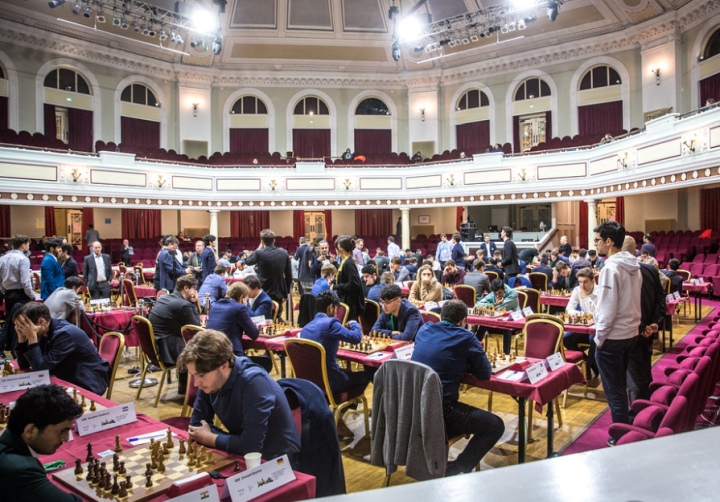
At 6:30 pm, fireworks and loud music were planned to take place some 150 meters from the Villa Marina, so in order not to affect the players, the organisation decided to move the round earlier.
It is not easy to adapt to changes in the usual routine, and this particularly applies to chess players, who like to have their days as predictable as possible. The brain gets used to hard work at certain hours, and then suddenly shifting this time to an earlier hour may result in the brain protesting and not functioning at optimal capacity.
Be that as it may, the players were at their boards at 11:30 am, and the round started without anybody being late. A crow that somehow found its way inside the venue celebrated this punctuality with loud caws for several minutes before seeing itself outside in the sunny weather.
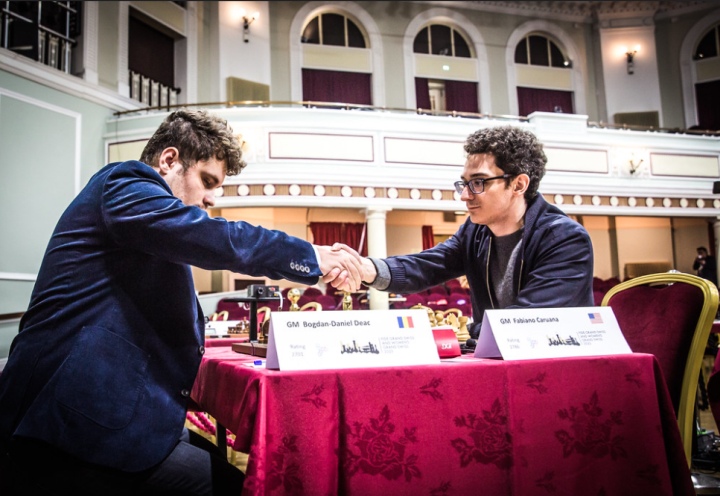
On board one, Fabiano Caruana used a rare idea in the Giuoco Piano against Bogdan-Daniel Deac. It has been employed only once before, in a correspondence game played in 2020.
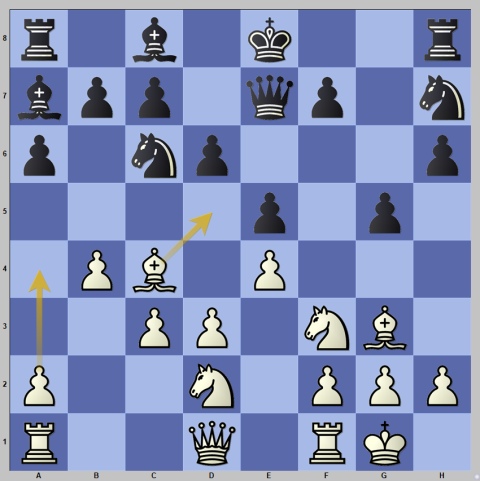
White usually plays 12.a4 in this position, but Caruana went for 12.Bd5!? instead, immediately using the fact that Black’s knight is no longer on f6 controlling the d5-square. The idea of the bishop move is to allow for the Nc4-e3 maneuver to target the weakened f5-square.
This move set Deac thinking, but despite that, the opponents followed the correspondence game Muljadi – Burgarth until move 16, when Deac deviated by castling short.
Whether it was because of the early starting hour or not, Caruana forgot his preparation and immediately ended up in a dangerous position.
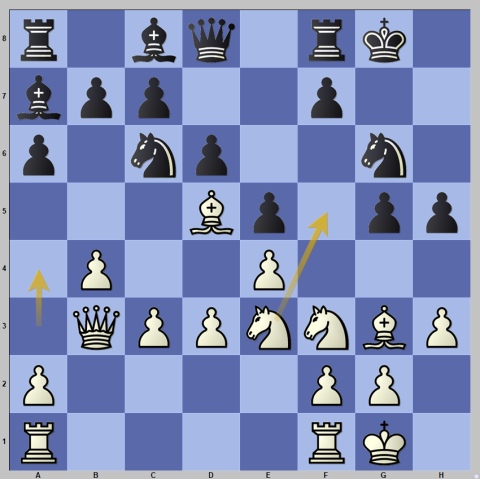
The position required concrete actions – 17.Nf5 Qf6 18.d4 with an unclear position. Caruana played the slow 17.a4? and after 17…g4! 18.hxg4 hxg4 19.Nh2 Qg5 was in real trouble.
He pursued his queenside activity with 20.b5, and here, Black missed a golden opportunity.
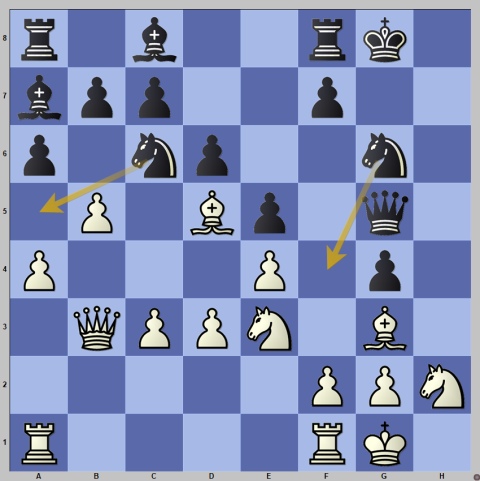
Bogdan-Daniel played the natural 20…Na5, and after the queen retreated to c2 he won a pawn by taking on e3 twice. However, Black could have played the very strong 20…Nf4! which would have given him a big advantage. The point of the move is that it doesn’t really sacrifice a piece because Black has …Ne2xg3 with checks when the knight on e3 is lost.
After Black won a pawn, White exchanged queens and obtained sufficient compensation for the pawn in the form of his better pieces and control over the f-file.
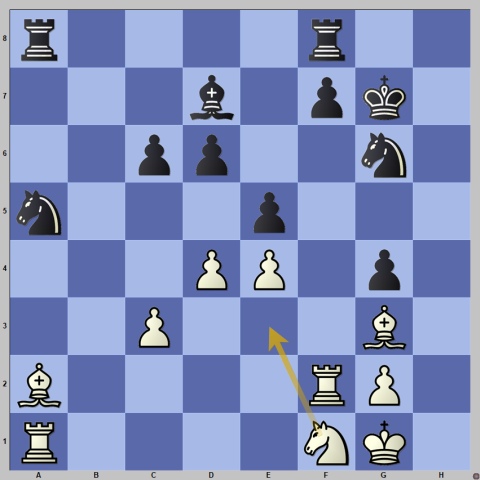
White threatens with Ne3, transferring the knight to an excellent square, where it targets the pawn on g4 and controls the f5-square. Caruana used his activity to regain the pawn and a draw was reached after 43 moves.
On board two, Vidit Santosh Gujrathi chose a popular line against Andrey Esipenko’s Ruy Lopez. In this line, White defends the e4-pawn with d3, saves his bishop from an exchange by playing a3 and develops the queen’s knight on c3.
Esipenko chose a variation where he exchanged the light-squared bishops, and soon enough, the players could have repeated moves.
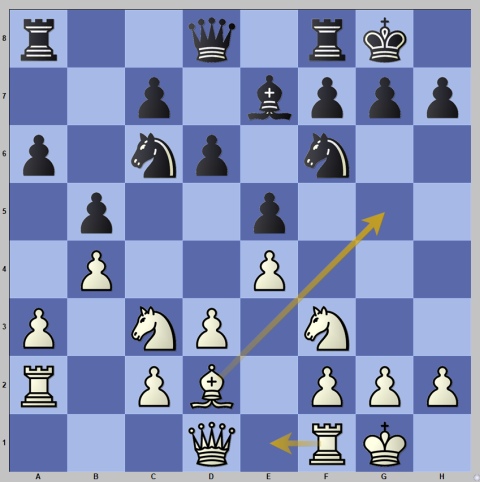
Many games were here with the repetition 15.Bg5 Ng4 (or 15…Nd7) 16.Bd2 Nf6, but Vidit decided to continue the game with 15.Re1.
The ensuing play unfolded on the queenside, where the a and b pawns were exchanged. The open files gave White some initiative, but Black remained solid.
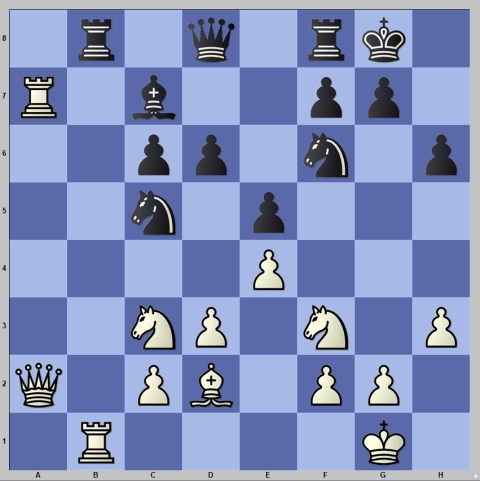
Without weaknesses on either side White’s control over the open files on the queenside can bring little. After the queens, one pair of rooks and the bishops were traded, a draw was agreed on move 37.
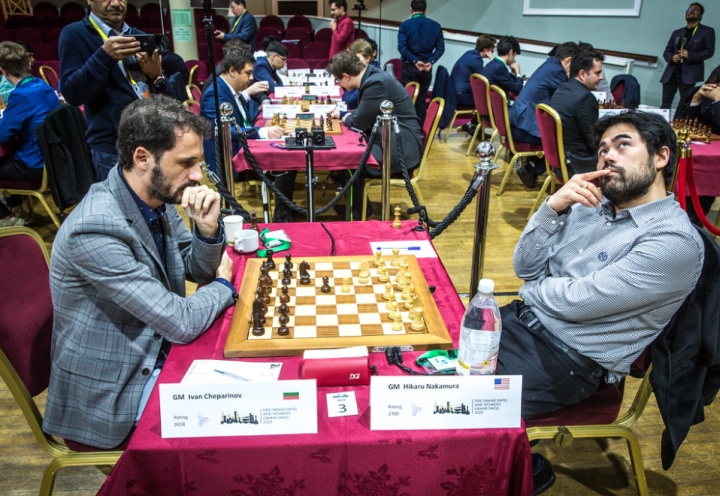
On board three, Hikaru Nakamura confidently played 1.e4 against Ivan Cheparinov, which was met by the Petroff Defence, a recent addition to Ivan’s repertoire. After the standard moves, Nakamura opted for the sideline 5.c4, aimed at reaching the usual Petroff positions by avoiding the main theoretical lines after the more usual 5.d4 d5 6.Bd3.
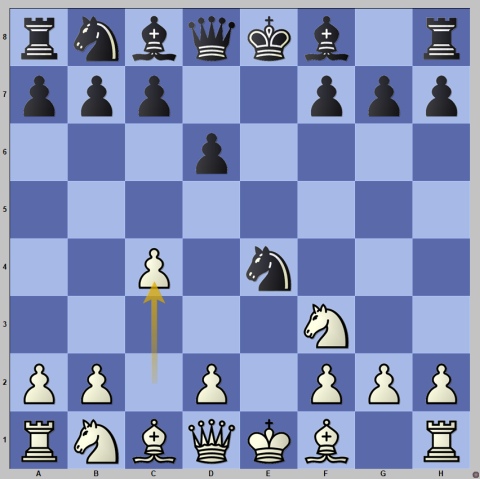
Even in a sideline, Cheparinov was well prepared and obtained a good middlegame position as both players finished development.
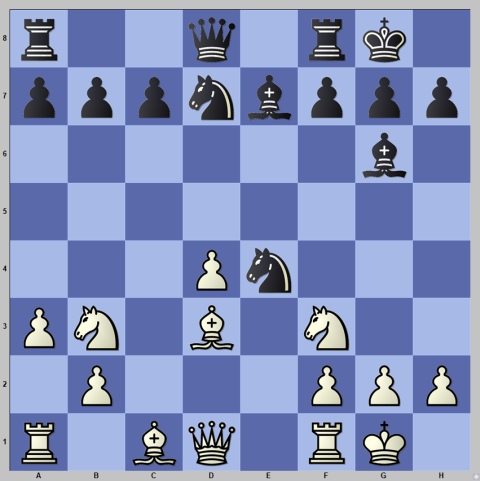
White’s IQP gave him a space advantage and free-piece play, while Black achieved smooth development, leading to a dynamically balanced middlegame.
The decisive moment in the game came relatively early.
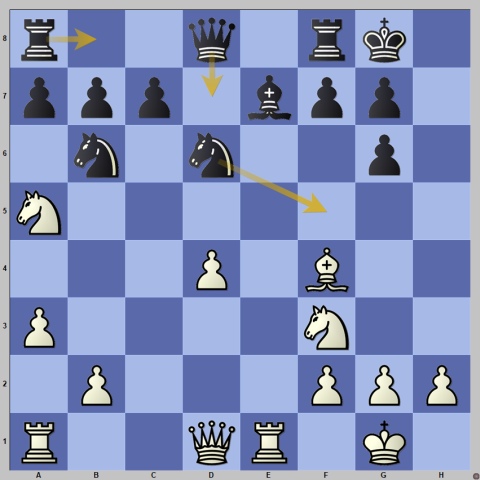
After 10 minutes of thinking, Cheparinov went for the pawn sacrifice 17…Nf5? instead of the composed 17…Rb8 or 17…Qd6 (intending to meet 18.Bxd6 with 18…cxd6) defending the attacked pawn on b7.
As it turned out, the sacrifice was not sound. After only three minutes, Nakamura picked up the pawn for nothing with 18.Nxb7 Qd5 19.Nc5. Perhaps what Cheparinov missed was that here 19…Bxc5 fails to 20.Re5! and White retains his extra pawn.
Further exchanges followed, and by move 30, White had a technically winning position.
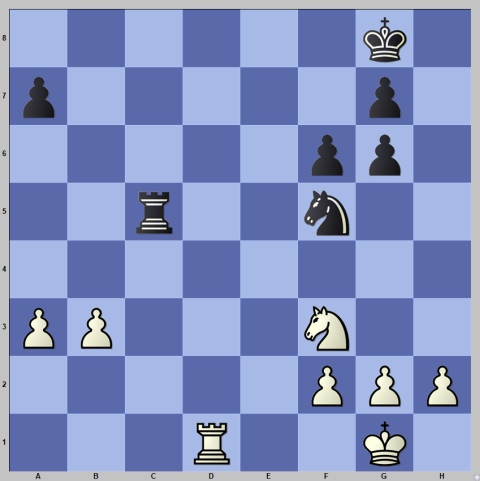
Nakamura is usually flawless when converting material advantage, and up to a certain point, that was the case in this game, too. However, on move 36 an interesting moment arose.
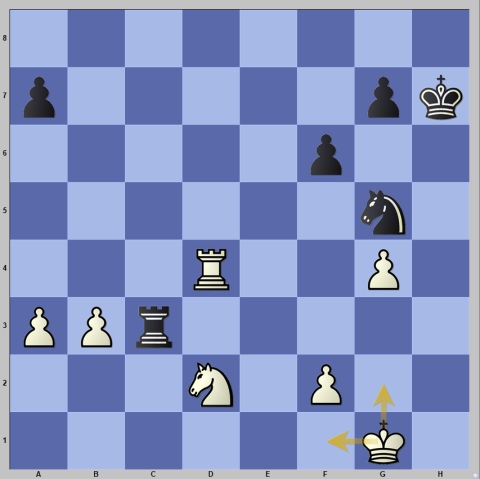
You wouldn’t expect it in this situation that White has only one (!) move to keep the winning advantage, but that was the case here. The move in case is 36.Kf1! with the idea of Ke2 was winning for White. Nakamura played 36.Kg2? and after 36…a5 37.f3 Ne6 Black got sufficient compensation for the pawn.
The position still required a great deal of accuracy from Black but Ivan made two imprecisions that again gave White a winning advantage.
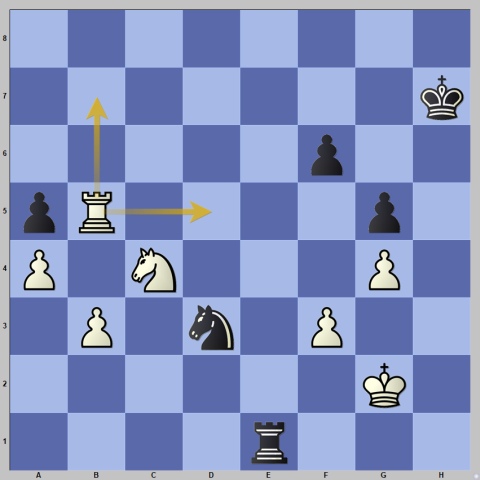
White could win with the accurate 45.Rd5! attacking the knight and not allowing it to come to the c5-square. The tactical point is that the fork 45…Nf4 is parried by attacks on the black rook after 46.Kf2 Re2 47.Kf1 and White picks up the pawn on a5.
Nakamura again missed the winning way and quickly played 45.Rb7? Kg6 46.Kf2, but after 46…Nc5 Black was in the drawing zone again.
The decisive moment in the endgame occurred on move 53. Black was on his last seconds, and he made the final mistake.
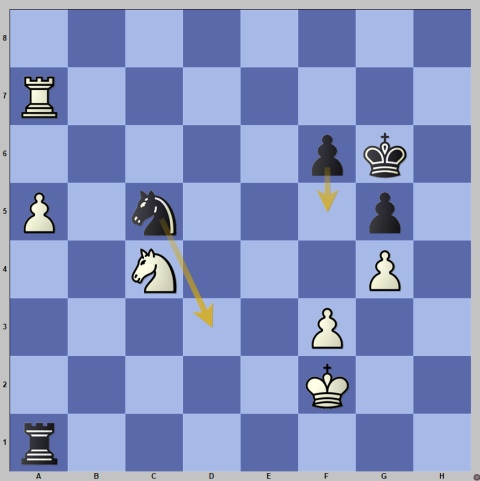
The saving move was 53…f5! in order to reduce the material on the kingside as much as possible.
Unfortunately for Cheparinov, he played 53…Nd3? 54.Ke3 Ne5, but the rook endgame that emerged after 55.Nxe5 fxe5 56.Ra6 Kf7 57.Ke4 was a smooth sail for White as Black’s king is cut off, and his pawns are weak.
In one of his videos, Nakamura was critical of the players’ rated 2550-2600 technique. He called it “sketchy at best.” One wonders how he would describe his own technique in this game.
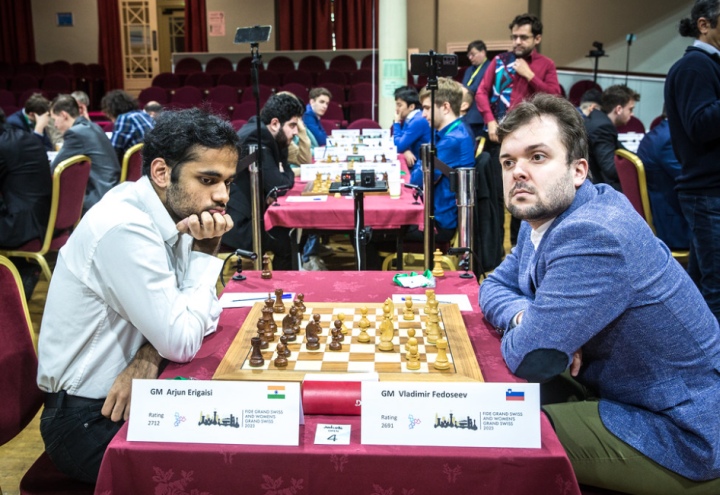
On board four, Vladimir Fedoseev and Arjun Erigaisi contested in the French Defence, not a very frequent opening at this tournament. After 3.Nc3 Black chose the Classical Variation with 3…Nf6 and White went for the Steinitz’s choice of 4.e5. The theory ended by move 13 when a standard French position emerged on the board.
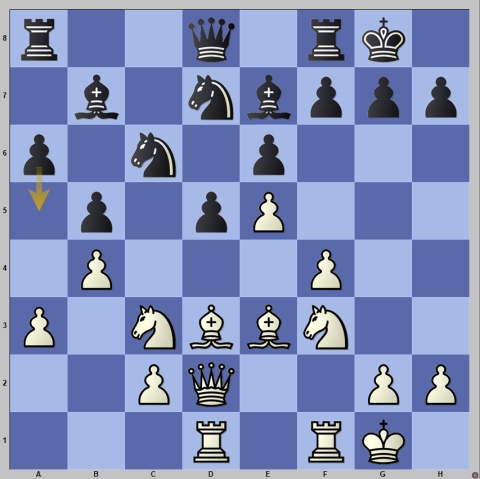
Black’s last move 14…a5 initiated activity on the queenside as Black was under the positional threat of being suffocated if White managed to transfer his knight from c3 to d4 via e2.
As both pairs of pawns on the queenside were exchanged, both sides tried to use the open a and b files, but this led to simplifications. Further on White traded his c-pawn for Black’s d5-pawn, and a symmetrical structure with pawns only on one wing was reached.
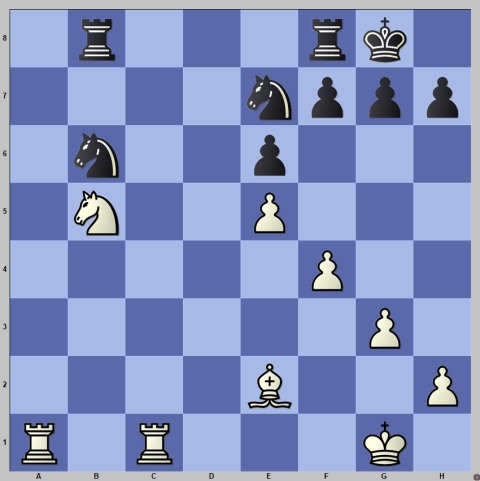
The limited material didn’t leave much play on the board, and a draw was agreed on move 45.
On the other boards, Parham Maghsoodloo scored an important win against Alexey Sarana, which allowed him to join the leaders.
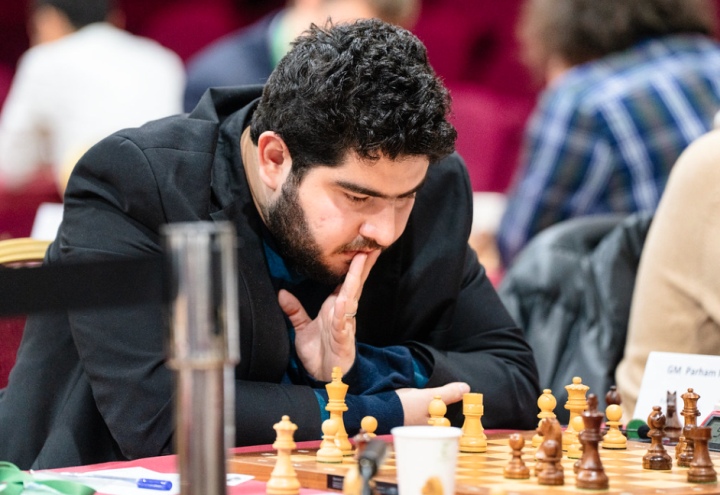
There are six players who have 6.5 points out of 9, Fabiano Caruana, Hikaru Nakamura, Santosh Gujrathi Vidit, Andrey Esipenko, Bogdan-Daniel Deac and Parham Maghsoodloo.
There are also six players who are half a point behind. It is getting crowded at the top.
In the women’s section, starting at 1 pm, everybody was on time, too.
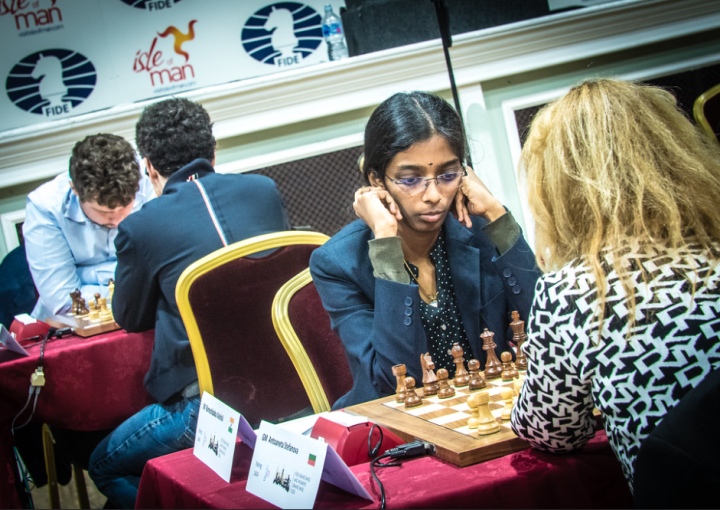
On board one, Antoaneta Stefanova chose an early fianchetto with White against Rameshbabu Vaishali after 1.d4 Nf6 2.Nf3 e6 3.g3. The intention with this safe development was to curb Vaishali’s tactical talent and propensity to dynamic play. The opponents soon left theory, and the position was a mix of the Catalan and the Queen’s Indian, where Black allowed a white knight on c6.
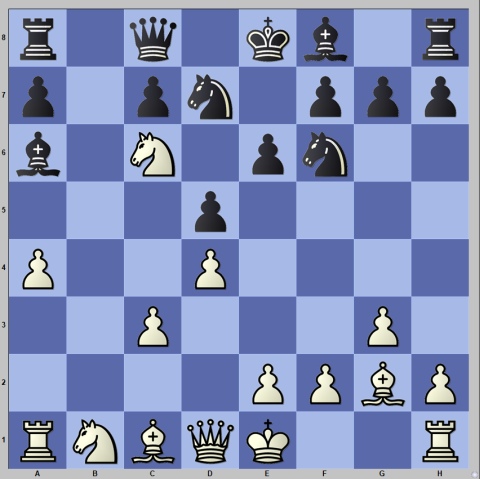
Black is not worried about the knight as it can be chased away easily. As the position is already original, both players started spending more time on their moves.
The dark-squared bishops were exchanged on a3, and White also eliminated Black’s remaining bishop. Antoaneta pushed c4 to open her fianchettoed bishop, and the position was now more resembling the Catalan.
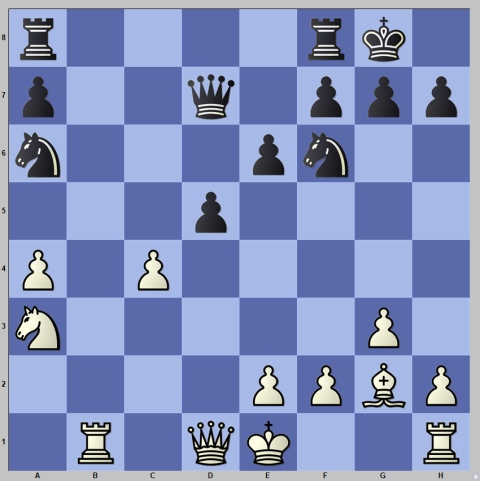
White activated her light-squared bishop, but with no real weaknesses in Black’s position, Vaishali didn’t have problems.
Still, with many pieces left on the board, a lot of calculation was required in the middlegame. Both players ended up in time trouble, but the balance was not disturbed.
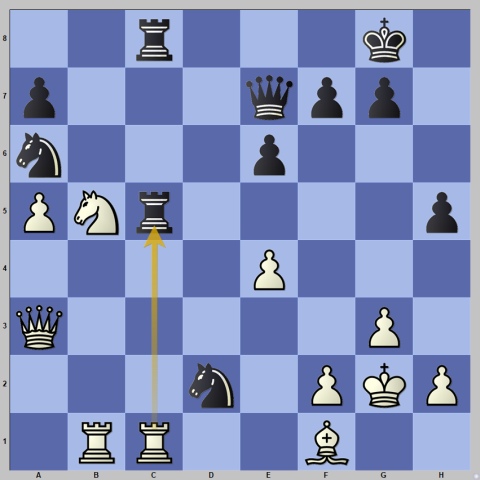
This looks scary for White, but after 28.Rxc5 Rxc5 29.Rd1 Nxe4 30.Qf3 Stefanova had sufficient compensation for the pawn.
However, a few moves later White lost her way.
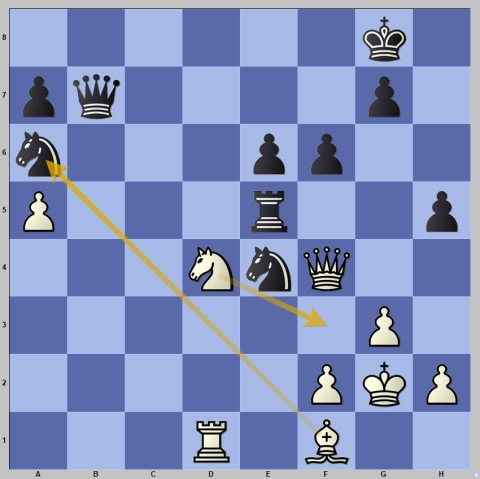
Here, the simplest was the forcing line 33.Bxa6 Qxa6 34.Nf3 Rd5 35.Rxd5 exd5 36.Qc7, where the active position of white’s queen prevents Black from making something out of the extra pawn.
White chose 33.Nf3, which was also fine, but on the next move after 33…Rxa5, she had to find 34.Bc4, with compensation, though this is obviously more complicated compared to the line mentioned above.
Stefanova erred with the impulsive 34.Rd8? as after 34…Kh7 Black improved the position of her king, and White was left with nothing for the opponent’s two pawns. The mutual time trouble led to exchanges of pieces, and after reaching the time control, Black was two pawns up in a technically winning rook endgame.
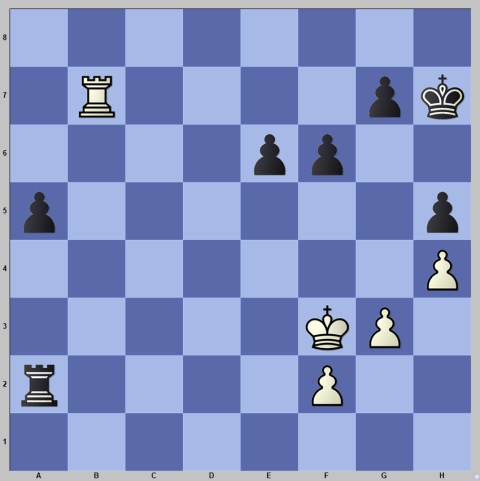
Black gradually converted her advantage, forcing White’s resignation on move 58.
On board two, Leya Garifullina chose the same line against the Ruy Lopez that she used yesterday to beat Shuvalova. It was the same line played a few boards away in the game Vidit – Esipenko. Anna Muzychuk’s preparation was based on the very recent game Anand – Svidler, played at the end of September.
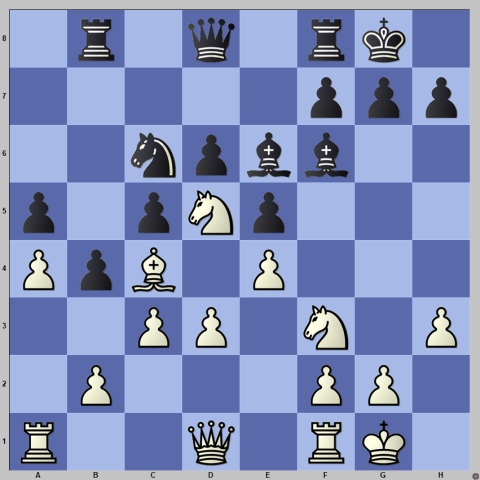
White’s central grip on the light squares is compensated with Black’s bishop pair and solid position. Black has long-term prospects on the kingside (by pushing …f5), and in the game Anand – Svidler Peter indeed obtained excellent attacking chances on the kingside and won.
It was Muzychuk who deviated from the game Anand – Svidler as after 17…h6 18.Qd2 she played 18…Kh7 instead of Svidler’s 18…Bg5. Her idea was to defend the h6-pawn and continue with …g6, …Bg7 and eventually push …f5.
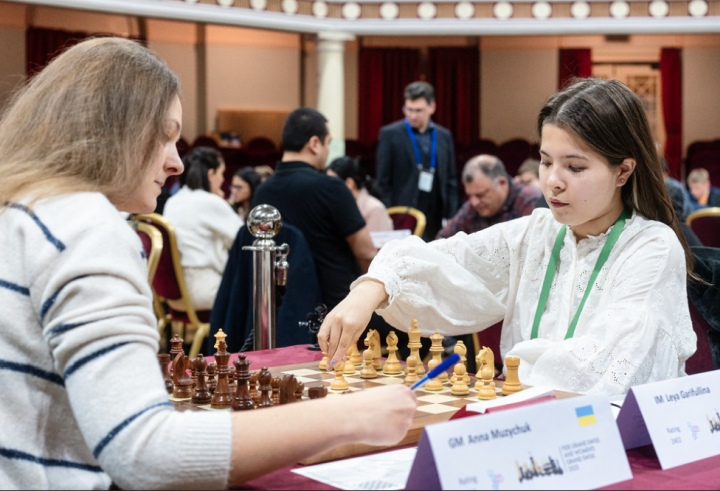
After Black played …g6, White eliminated the dark-squared bishop by taking it with her knight, when the black queen replaced the bishop on the f6-square. White continued to control the d5-square, but Black’s pieces were successfully playing around it, a ploy known from the Sveshnikov Sicilian.
On move 26, White went for the wrong exchange.
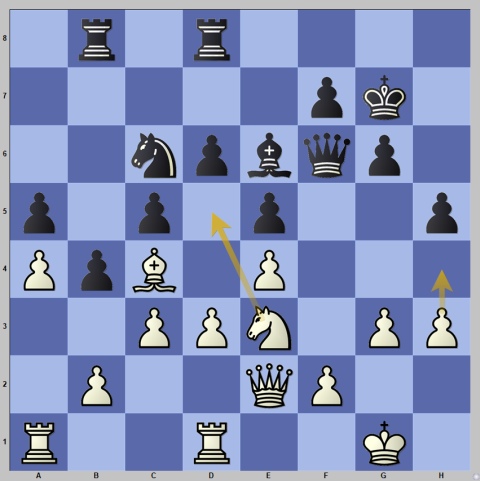
With 26.h4 White would have kept the position in balance whereas after 26.Nd5?! Bxd5 27.Bxd5 Ne7, it was Black who obtained the preferable chances. White’s light-squared bishop looks great, but it’s an ineffective piece, as there is nothing to attack on the a2-g8 diagonal, while the knight can hop around in search of greener pastures. In addition to this, after 28.Bc4 h4! Black managed to weaken White’s kingside.
These developments gave Black the initiative, but after the initial build-up (by doubling the rooks on the h-file by …Rh5 and …Rbh8), Black didn’t see a way to continue and allowed White to close the kingside by pushing g4.
After the time control, the following position was reached.
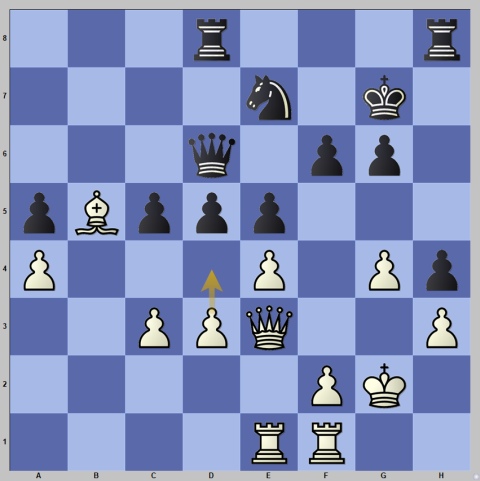
Garifullina decided to blast the centre open with 41.d4. This decision led to mass exchanges, and an equal double-rook endgame was reached.
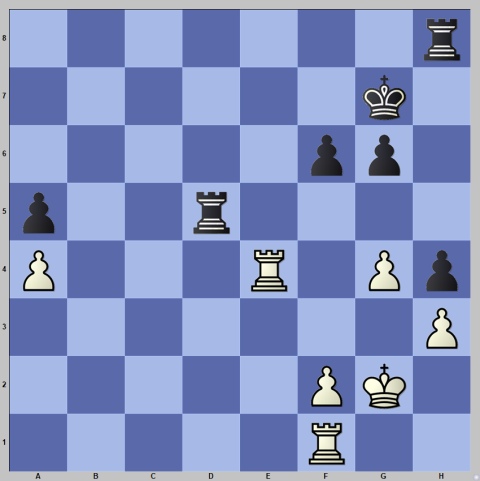
This should have been drawn shortly, but somehow Black lost a pawn, and White obtained the moral advantage in a drawn rook endgame of three pawns versus two on the same wing.
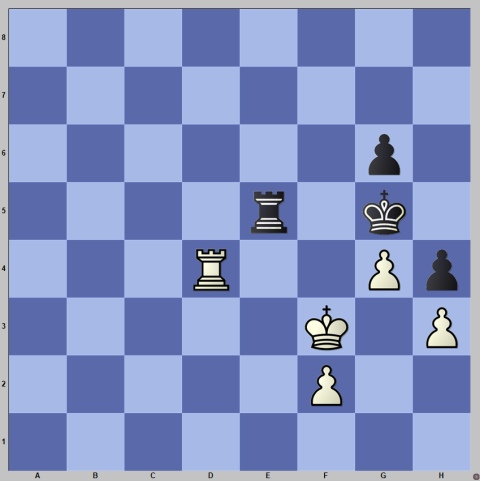
White tried to make something out of nothing but eventually agreed to a draw after 84 moves.
On board three, Sophie Milliet played the Alapin Variation (a popular choice at this tournament!) against Tan Zhongyi’s Sicilian Defence. Black chose 2…Nf6 and a typical position for this line was reached.
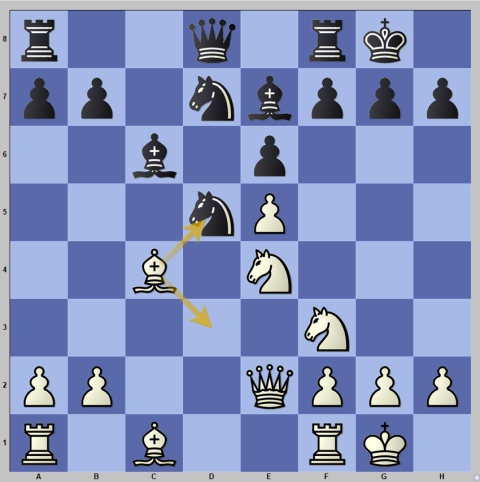
Black obtained comfortable development, which made it difficult for White to create threats on the kingside. White’s next move, however, was a mistake. She should have played 13.Bxd5 Bxd5 14.Nc3 Bc6 15.Nd4, seeking simplifications because Black’s harmonious position didn’t allow for any activity. Instead, Milliet opted for the natural 13.Bd3, taking aim at Black’s kingside, but after 13…Qc7, it turned out that White had problems defending the e5-pawn while Black also threatened…Nb4 to go after White’s valuable light-squared bishop.
White decided to go va banque with 14.Neg5 h6 15.Nh7, sentencing the wayward knight to a very short life as it was obvious the knight would never make it alive out of h7. Black could have been more ambitious to try to capture it, but even exchanging it was sufficient to defuse White’s possible threats on the kingside and allow Black to take over the queenside.
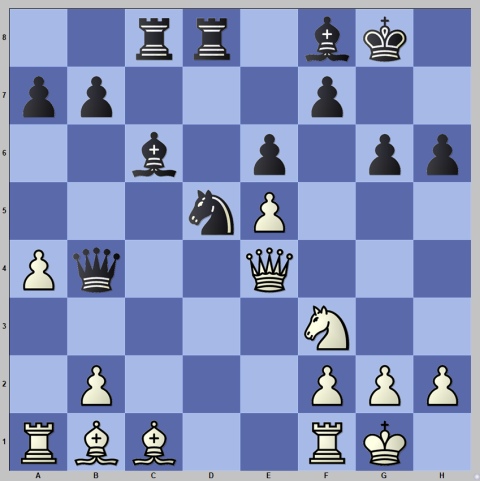
It may not seem much at first sight, but in fact, White is in serious trouble in this position. Black has superior development and is slowly clamping on White’s queenside. White’s position is over-extended due to the pawn on e5, which often turns into a weakness when it doesn’t give attacking chances.
White couldn’t stop Black’s advances on the queenside, and her position collapsed quickly.
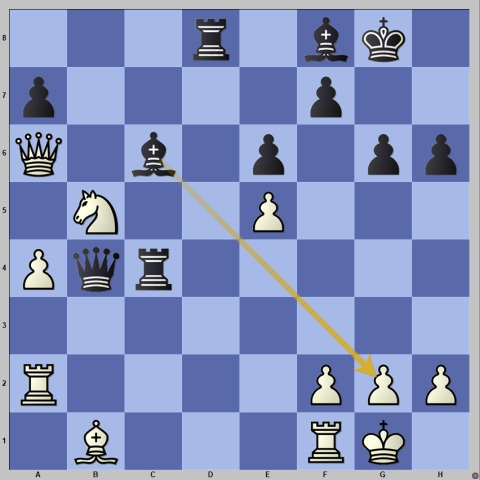
Black is winning in more than one way and here she chose the petite combinaison with 29…Bxg2! 30.Kxg2 Rg4+ 31.Kh1 Qc4, with an attack on White’s rook on f1. The rook cannot escape because then …Qd5 leads to mate, so White was forced to return the piece with 31.Nc7 Qxc7, but she was left with a weak king and a pawn down. Soon she also lost the pawn on a4, and Black converted her winning advantage.
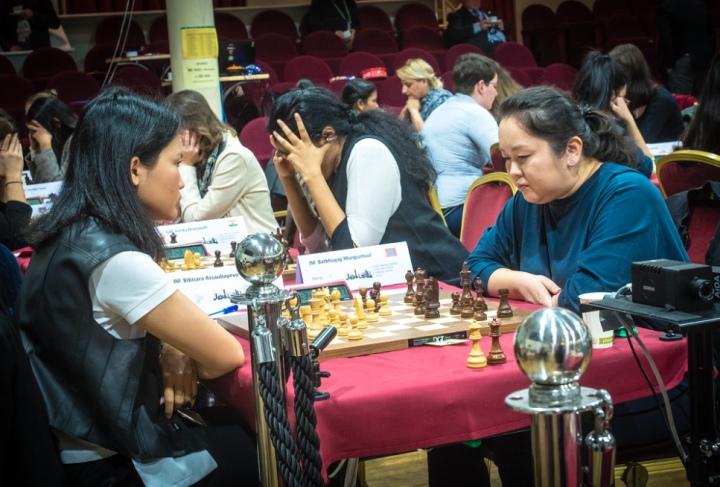
On board four, Bibisara Assaubayeva changed her usual approach with the white pieces to seek slow play and delay the confrontation to the middlegame and went for one of the sharpest lines in the Meran against Batkhuyag Munguntuul. However, it seemed that she couldn’t recall her preparation as in the tabiya of this line, she went for a clearly inferior variation.
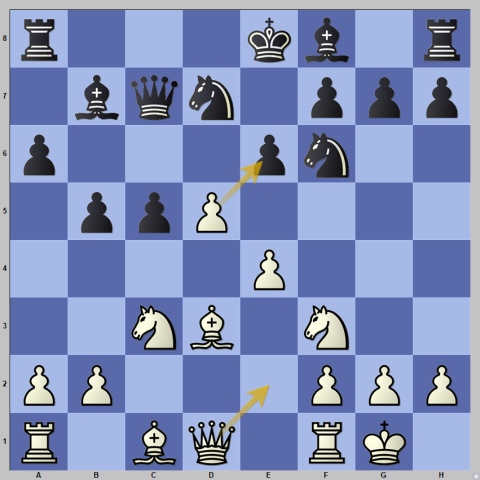
In this position, White has a wide choice, with the main one being 12.dxe6. Bibisara played 12.Qe2, which is also fine, but after 12…Bd6 she went for the inferior 13.Re1?! (instead of 13.dxe6) and after the natural 13…Ne5 Black already had excellent play.
After Black missed a forceful way to impose her advantage, an extremely sharp position emerged on the board.
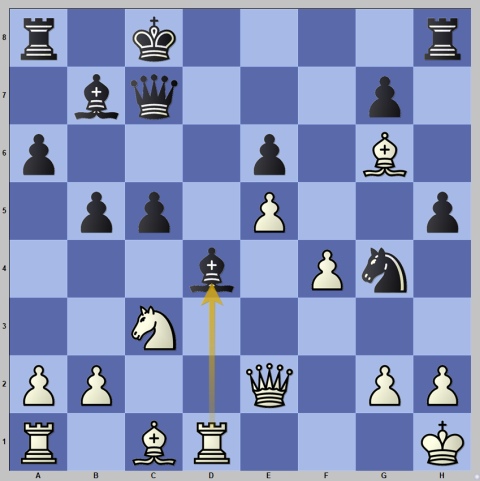
Black’s king walked to c8, and this is inconvenient for Black as she cannot connect the rooks, but all her minor pieces are dangerously eyeing White’s king. White is in danger of coming under serious attack if Black manages to bring her queen to the kingside, for example, via e7 to h4.
With this in mind, Assaubayeva sacrificed an exchange with 21.Rxd4!? cxd4 22.Ne4, which only added fuel to the fire.
The position was extremely complicated, but both players played well, but right before the time control, White made a mistake.
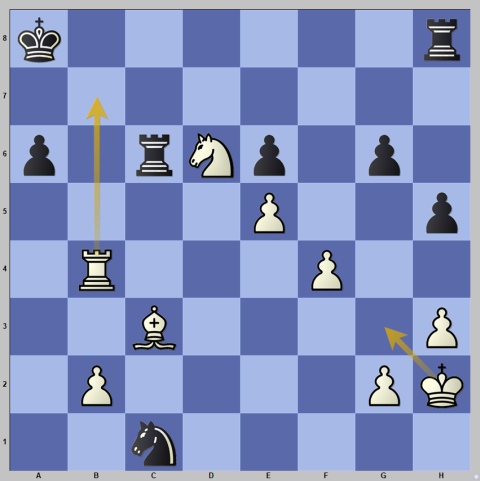
The move 38.Kg3 would have kept the dynamic equilibrium but after the tempting 38.Rb7? Ne2! 39.Re7 Nxc3 40.bxc3 Black had a minute to make the fateful 40th move.
Unfortunately, Munguntuul immediately played 40…Rxc3? whereas the very strong 40…a5! would have given her a winning advantage: the a-pawn runs fast and can be supported by the rook from behind.
After the move played in the game, White won both pawns on e6 and a6 and escaped the danger of losing.
The win in today’s game made Rameshbabu Vaishali the sole leader with 7 out 9. She is followed by Anna Muzychuk and Tan Zhongyi, who have 6.5 points.
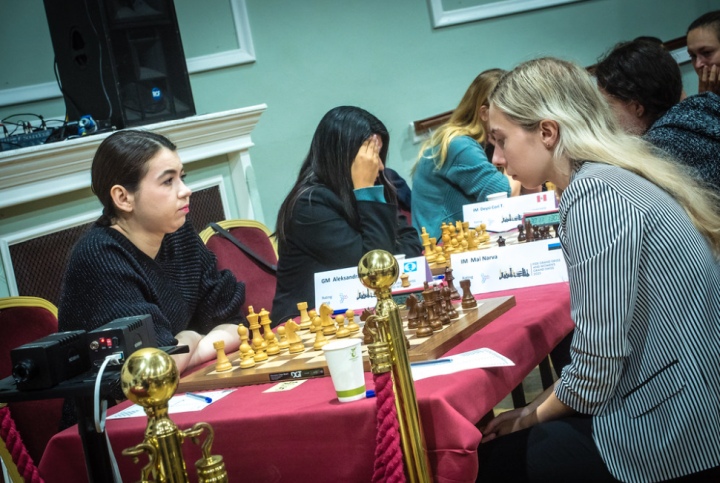
Of the other results, it is worth noting the win of Mai Narva with the black pieces against the top seed Aleksandra Goryachkina. After this victory, Narva has 6 points, while the loss eliminated Goryachkina from the fight for the top spots.
Fans can follow the Grand Swiss 2023 by watching live broadcasts of the event on FIDE Youtube and Twitch with expert commentary by GM David Howell and IM Jovanka Houska.
Round 10 will be played on November 4.
Written by GM Alex Colovic
Photos: Anna Shtourman and Maria Emelianova/Chess.com
Official website: grandswiss.fide.com
About the event:
The FIDE Grand Swiss and FIDE Women’s Grand Swiss 2023 takes place from the 23rd of October to the 6th of November at the Villa Marina, Douglas, Isle of Man.
Both tournaments are part of the qualifications for the World Championship cycle, with the top two players in the open event qualifying for the 2024 Candidates Tournament and the top two players in the Women’s Grand Swiss qualifying for the 2024 Women’s Candidates.
Eleven rounds will be played under the Swiss System, with 164 players participating from all continents: 114 in the Grand Swiss and 50 players in the Women’s Grand Swiss.
The total prize fund is $600,000, with $460,000 for the Grand Swiss and $140,000 for the Women’s Grand Swiss.
The first Grand Swiss was held in 2019 in the Isle of Man and was won by GM Wang Hao, who scored 8/11. The 2021 edition was moved from Isle of Man to Riga due to Covid restrictions on the island and was won by GM Alireza Firouzja.
This is the second time that a Women’s Grand Swiss event will be held. The inaugural edition in Riga was won by GM Lei Tingjie.
Organizers and Partners:








